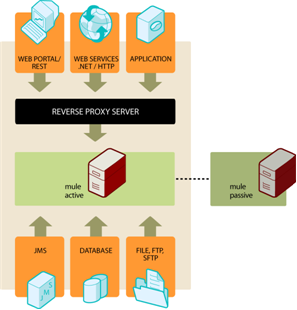Mule High Availability provides basic failover capability for Mule ESB. When the primary Mule instance become unavailable (e.g., because of a fatal JVM or hardware failure or it’s taken offline for maintenance), a backup Mule instance immediately becomes the primary node and resumes processing where the failed instance left off. After a system administrator has recovered the failed Mule instance and brought it back online, it automatically becomes the backup node.
Seamless failover is made possible by a distributed memory store that shares all transient state information among clustered Mule instances. This can include information in SEDA service event queues and in-memory message queues.
Mule High Availability is currently available for the following transports:
-
HTTP (including CXF Web Services)
-
JMS
-
WebSphere MQ
-
JDBC
-
File
-
FTP
-
VM




